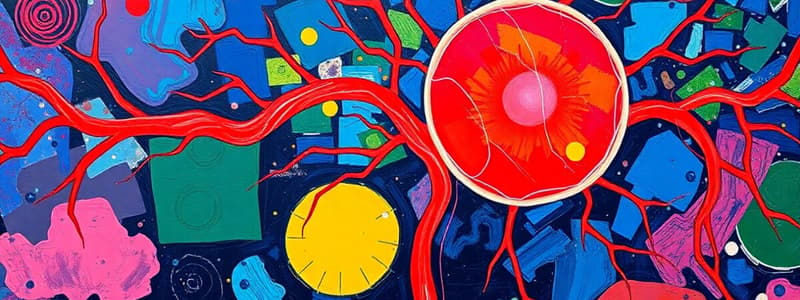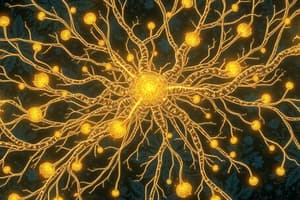Podcast
Questions and Answers
Which of these is NOT a component of the control and coordination process?
Which of these is NOT a component of the control and coordination process?
- Receptors
- Effectors
- Digestion (correct)
- Stimulus
The Central Nervous System (CNS) includes nerves that connect the brain and spinal cord to the rest of the body.
The Central Nervous System (CNS) includes nerves that connect the brain and spinal cord to the rest of the body.
False (B)
What are the two main parts of the nervous system?
What are the two main parts of the nervous system?
Central Nervous System (CNS) and Peripheral Nervous System (PNS)
_______ are specialized cells or groups of cells that are sensitive to particular stimuli.
_______ are specialized cells or groups of cells that are sensitive to particular stimuli.
Match the following receptors with the stimuli they detect:
Match the following receptors with the stimuli they detect:
Which of the following is an example of an effector?
Which of the following is an example of an effector?
Spinal nerves connect directly to the brain.
Spinal nerves connect directly to the brain.
What is the reaction of the body to a stimulus called?
What is the reaction of the body to a stimulus called?
Which of the following is the correct sequence of components involved in a nervous system response?
Which of the following is the correct sequence of components involved in a nervous system response?
Myelin sheath slows down the transmission of signals along the axon.
Myelin sheath slows down the transmission of signals along the axon.
What is the main function of dendrites in a neuron?
What is the main function of dendrites in a neuron?
The gap between two neurons where neurotransmitters diffuse is called the ______.
The gap between two neurons where neurotransmitters diffuse is called the ______.
Match the neuron type with its function:
Match the neuron type with its function:
Where does the nerve impulse transmission occur in a muscle fiber?
Where does the nerve impulse transmission occur in a muscle fiber?
The strength of a nerve impulse is determined by its amplitude.
The strength of a nerve impulse is determined by its amplitude.
What is the main function of the central nervous system?
What is the main function of the central nervous system?
The brain is protected by the cranium and three membranes called the ______.
The brain is protected by the cranium and three membranes called the ______.
Match the brain region with its primary function:
Match the brain region with its primary function:
Which part of the forebrain is responsible for vision?
Which part of the forebrain is responsible for vision?
The cerebellum is a part of the hindbrain and controls involuntary actions like breathing.
The cerebellum is a part of the hindbrain and controls involuntary actions like breathing.
What is the function of the spinal cord?
What is the function of the spinal cord?
The vertebral column protects the ______.
The vertebral column protects the ______.
What is the immediate trigger for a reflex action?
What is the immediate trigger for a reflex action?
Which of the following is NOT a component of the reflex arc?
Which of the following is NOT a component of the reflex arc?
Voluntary actions are primarily controlled by the midbrain and hindbrain.
Voluntary actions are primarily controlled by the midbrain and hindbrain.
What fluid surrounds the brain and spinal cord to provide protection?
What fluid surrounds the brain and spinal cord to provide protection?
The _________ is considered the master control center for hormonal regulation.
The _________ is considered the master control center for hormonal regulation.
Match the following glands with their primary function:
Match the following glands with their primary function:
What is the role of the motor neuron in a reflex arc?
What is the role of the motor neuron in a reflex arc?
The brain has no role in reflex actions, they are entirely controlled by the spinal cord.
The brain has no role in reflex actions, they are entirely controlled by the spinal cord.
What is the primary function of the vertebral column?
What is the primary function of the vertebral column?
The hormone _________ , released by the thyroid gland, helps regulate metabolism.
The hormone _________ , released by the thyroid gland, helps regulate metabolism.
Match the following terms with their description:
Match the following terms with their description:
What is the main purpose of reflex actions?
What is the main purpose of reflex actions?
The thymus is most active during adulthood.
The thymus is most active during adulthood.
What is the function of the relay neuron?
What is the function of the relay neuron?
The _____ gland releases parathormone, which is important for calcium regulation.
The _____ gland releases parathormone, which is important for calcium regulation.
Flashcards
Control & Coordination
Control & Coordination
The process by which organisms react to changes in their environment, both internal and external.
Nervous System
Nervous System
The network of specialized cells responsible for coordinating all body activities.
Central Nervous System (CNS)
Central Nervous System (CNS)
The control center of the Nervous System, made up of the brain and spinal cord.
Peripheral Nervous System (PNS)
Peripheral Nervous System (PNS)
Signup and view all the flashcards
Stimulus
Stimulus
Signup and view all the flashcards
Receptors
Receptors
Signup and view all the flashcards
Effectors
Effectors
Signup and view all the flashcards
Response
Response
Signup and view all the flashcards
Neuron
Neuron
Signup and view all the flashcards
Dendrites
Dendrites
Signup and view all the flashcards
Cell Body (Soma)
Cell Body (Soma)
Signup and view all the flashcards
Axon
Axon
Signup and view all the flashcards
Myelin Sheath
Myelin Sheath
Signup and view all the flashcards
Nerve Endings
Nerve Endings
Signup and view all the flashcards
Synaptic Knobs
Synaptic Knobs
Signup and view all the flashcards
Synaptic Vesicles
Synaptic Vesicles
Signup and view all the flashcards
Sensory Neurons
Sensory Neurons
Signup and view all the flashcards
Motor Neurons
Motor Neurons
Signup and view all the flashcards
Interneurons (Relay Neurons)
Interneurons (Relay Neurons)
Signup and view all the flashcards
Relay Neuron
Relay Neuron
Signup and view all the flashcards
Reflex Arc
Reflex Arc
Signup and view all the flashcards
Meninges
Meninges
Signup and view all the flashcards
Cerebrospinal Fluid (CSF)
Cerebrospinal Fluid (CSF)
Signup and view all the flashcards
Voluntary Actions
Voluntary Actions
Signup and view all the flashcards
Involuntary Actions
Involuntary Actions
Signup and view all the flashcards
Exocrine Glands
Exocrine Glands
Signup and view all the flashcards
Endocrine Glands
Endocrine Glands
Signup and view all the flashcards
Hypothalamus
Hypothalamus
Signup and view all the flashcards
Pituitary Gland
Pituitary Gland
Signup and view all the flashcards
Thyroid Gland
Thyroid Gland
Signup and view all the flashcards
Insulin
Insulin
Signup and view all the flashcards
Study Notes
Control and Coordination
- Control and Coordination is the process organisms use to respond to changes in their internal and external environments, including stimuli like heat, pain, light, sound, smell, and taste.
- The Nervous System coordinates bodily activities.
- The Nervous System has two main parts:
- Central Nervous System (CNS): Composed of the Brain and Spinal Cord.
- Peripheral Nervous System (PNS): Consists of nerves connecting the CNS to the rest of the body.
Human Nervous System
- The Human Nervous System is responsible for responding to stimuli and coordinating bodily functions.
- The Human Nervous System has two main branches, the CNS and the PNS.
- The CNS receives sensory information and transmits signals throughout the body.
- The PNS connects the CNS to the rest of the body, transmitting signals to and from the CNS.
- The PNS includes:
- Spinal Nerves, connecting to the Spinal Cord.
- Cranial Nerves, connecting to the Brain.
- Visceral Nerves, connecting to internal organs.
Components of Control and Coordination
Stimulus
- A stimulus is a change in the environment detected by an organism. Examples include:
- Heat
- Pain
- Light
- Sound
- Smell
- Taste
Receptors
- Receptors are specialized cells detecting specific stimuli. Examples include:
- Photoreceptors (light)
- Phonoreceptors (sound)
- Thermoreceptors (heat)
- Olfactory Receptors (smell)
- Gustatory Receptors (taste)
Effectors
- Effectors are muscles or glands responding to stimuli.
- Effectors produce a response to the stimulus, receiving signals from the brain or spinal cord. Examples include:
- Muscles (moving body parts)
- Glands (producing hormones or other substances)
Response
- A response is the body's reaction to a stimulus. The response is a result of nervous system activity. Example: touching a hot stove—your hand quickly moves away. The heat was the stimulus, your hand moving away was the response.
The Nervous System
- The nervous system receives stimuli, processes information, and sends signals to effectors for a response.
- Four essential components:
- Stimulus: The trigger.
- Receptor: Detects the stimulus.
- Effector: Carries out the response.
- Response: Body's reaction to the stimulus.
The Neuron
- Neurons are the structural and functional units of the nervous system; transmitting signals throughout the body.
- Neuron Structure:
- Dendrites: Branching extensions receiving signals from other neurons.
- Cell Body (Soma): Contains the nucleus and integrates signals.
- Axon: Long extension transmitting signals away from the cell body.
- Myelin Sheath: Fatty covering insulating the axon, speeding up signal transmission.
- Nerve Endings: Terminal branches of the axon releasing neurotransmitters.
- Synaptic Knobs: Swellings at ends of nerve endings, containing synaptic vesicles.
- Synaptic Vesicles: Small sacs storing neurotransmitters.
Neuron Function
- Signal Transmission:
- Stimulus Detection: Dendrites receive signals from other neurons or sensory receptors.
- Signal Conversion: Incoming signal becomes electrical within the neuron.
- Signal Transmission: Electrical signal travels down the axon to nerve endings.
- Neurotransmitter Release: Electrical signal triggers neurotransmitter release at nerve endings.
- Synaptic Transmission: Neurotransmitters cross the synaptic cleft, a gap between neurons, and bind to receptors on the next neuron, continuing the signal.
Types of Neurons
- Sensory Neurons: Transmit signals from sensory receptors to the CNS.
- Motor Neurons: Carry signals from the CNS to effectors.
- Interneurons (Relay Neurons): Connect sensory and motor neurons, processing information in the CNS.
Neuromuscular Junction
- The neuromuscular junction is where a motor neuron contacts a muscle fiber, transmitting impulses to the muscle. Neurotransmitters initiate muscle contraction.
Nerve Impulses
- A nerve impulse is a wave of electrical and chemical signals along a neuron.
- Signal Strength is determined by impulse frequency, not amplitude.
Study Notes for Human Nervous System
- The Nervous System controls and coordinates bodily functions, enabling communication between different body parts.
- The Central Nervous System (CNS) is the body's control center, consisting of the Brain and Spinal Cord.
Brain: The Control Center
- Brain: The body's highest coordinating center.
- Location: Inside the skull.
- Protection: Protected by the cranium, meninges, and cerebrospinal fluid (CSF).
- CSF acts as a shock absorber, shielding the brain from injury.
Brain Regions
- Three major regions: Forebrain, Midbrain, and Hindbrain.
Forebrain
- Cerebrum: Largest part, responsible for memory, learning, reasoning, and voluntary actions. Subdivided into four lobes:
- Frontal Lobe: Memory, learning, reasoning, and planning.
- Temporal Lobe: Hearing, smell, and language comprehension.
- Parietal Lobe: Touch, taste, and spatial awareness.
- Occipital Lobe: Vision and visual processing.
- Thalamus: Relays sensory information to the cerebrum.
- Hypothalamus: Controls body temperature, thirst, hunger, and hormone release; crucial for sleep-wake cycle.
Hindbrain
- Cerebellum: Coordinates balance, posture, and voluntary movements.
- Medulla: Located at the base, controls involuntary actions like respiration, heart rate, and blood pressure.
- Pons: Regulates respiration and acts as a bridge between cerebellum and other brain parts.
Spinal Cord: The Communication Highway
- Spinal Cord: Long, cylindrical structure transmitting signals between brain and body.
- Location: Runs through the vertebral column.
- Protection: Protected by the vertebral column.
- Nerves: 31 pairs of nerves emerge, carrying signals to and from the brain.
- Function: Conducts nerve impulses to and from the brain.
Reflex Action: Quick Responses
- Reflex Action: Rapid, involuntary response. Example: touching a hot stove.
- Process: Stimulus, receptor, sensory neuron, relay neuron, motor neuron, effector, response.
Reflex Arc
- Reflex Arc: Nerve impulse pathway in a reflex action, including sensory receptor, sensory neuron, relay neuron, motor neuron, and effector.
Protection of Nervous Organs
- Brain: Protected by the cranium, meninges, and cerebrospinal fluid.
- Spinal Cord: Protected by the vertebral column and cerebrospinal fluid.
The Reflex Arc
- The reflex arc is the pathway of nerve impulses during a reflex action.
- It involves a stimulus, receptor, sensory neuron, central nervous system, motor neuron, effector organ and response.
- The reflex arc is a basic pathway, and the diagrams from NCERT are useful for understanding it fully.
- The reflex action occurs with the help of the spinal cord, but the brain also plays a role in the reflex arc.
- The brain stores information about past experiences, which is important for recognizing harmful and potentially life-threatening situations.
- When an individual experiences a stimulus, like touching a hot object, the information is sent to the brain and stored as a memory.
- The brain then triggers a response to avoid the stimulus in the future.
- The stored information is a key component of the reflex action.
- When answering exam questions about the reflex arc, it's important to note the brain's role in preparing for the future.
Brain and Reflex Actions
- The brain plays a role in reflex actions, even though these actions are primarily controlled by the spinal cord. The brain stores past experiences.
Voluntary and Involuntary Actions
- Voluntary actions are consciously controlled; primarily controlled by forebrain.
- Involuntary actions are not consciously controlled; controlled by midbrain and hindbrain. Reflex action is controlled by the spinal cord.
The Need for Reflex Actions
- Reflex actions are essential for quick responses in emergency situations to minimize harm. They protect against injury or danger. They are crucial for survival.
Glands
- Glands are structures secreting specific substances. Two types: exocrine and endocrine.
Exocrine Glands
- Exocrine glands release substances through ducts, not hormones. Examples: salivary glands, tear glands.
Endocrine Glands
- Endocrine glands release hormones directly into the bloodstream, affecting target cells and organs. Examples: adrenal glands, pituitary gland, thyroid gland.
Hypothalamus
- The hypothalamus is a brain region controlling hormone release from other glands; the "master control center" for hormonal regulation.
Pituitary Gland
- The pituitary gland is located under the hypothalamus and releases various hormones, including growth hormone. It controls growth, development, metabolism, and other bodily functions.
Thyroid Glands
- The thyroid gland is located in the neck and releases thyroxine, a hormone containing iodine. Thyroxine regulates metabolism, affecting the breakdown of carbohydrates, fats, and proteins.
Parathyroid Glands
- The parathyroid glands, near the thyroid, release parathyroid hormone (parathormone).
- Parathyroid hormone regulates calcium and phosphate levels in the blood.
Thymus
- The thymus, in the chest, is crucial for immune system development, most active during childhood.
Pancreas
- The pancreas is in the abdomen, with both exocrine and endocrine functions.
- Exocrine: Releases pancreatic juice containing digestive enzymes.
- Endocrine: Releases insulin, a hormone regulating blood sugar levels.
Insulin
- Insulin, produced by the pancreas, lowers blood glucose levels by promoting glucose uptake into cells and glycogen storage. Insufficient insulin production leads to diabetes.
Glycogen
- Glycogen is a complex carbohydrate stored in the liver and muscles as a reserve energy source. Insulin helps convert excess glucose to glycogen, preventing high blood sugar.
Studying That Suits You
Use AI to generate personalized quizzes and flashcards to suit your learning preferences.





